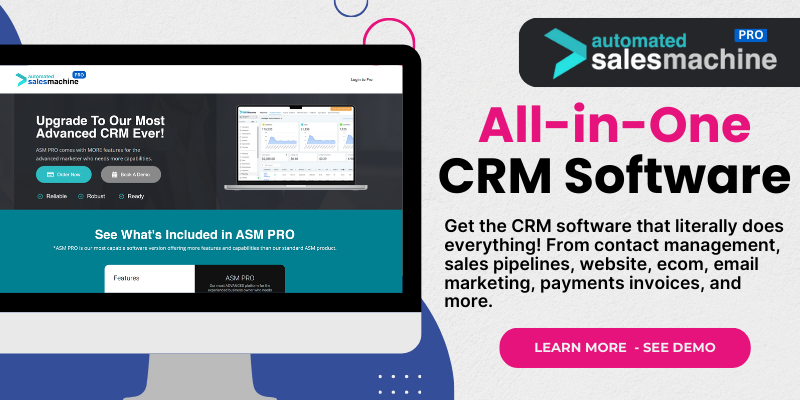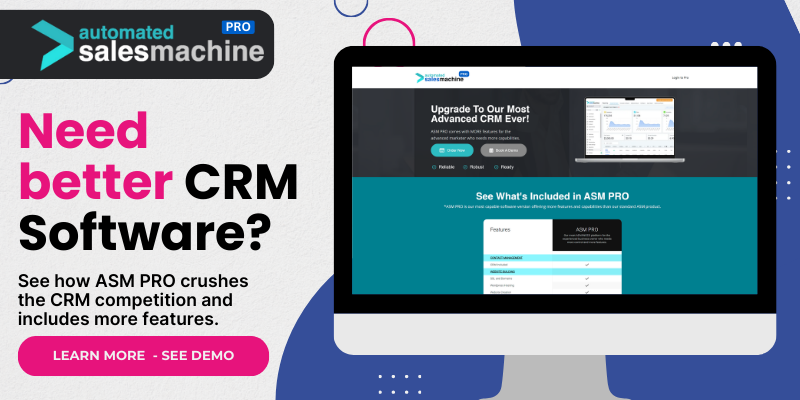So, you’re in the market for a CRM, huh? I’ve been there, and trust me, it can feel overwhelming with a ton of options out there. But fear not! I’m here to share my experiences on how to compare 10 different CRM software options. Let’s break it down into some manageable parts, shall we?
1. Identify Your Business Needs
Understand Your Goals
Before diving into demos and pricing, I always start by looking at my business goals. What do I actually want to achieve with a CRM? Are you looking for better customer relationships, streamlined communication, or increased sales? Pinning down your objectives can significantly narrow down your choices.
For instance, if your main goal is to enhance customer service, it’s wise to prioritize features that help you manage customer support tickets or feedback. Understanding your goals not only helps clarify your needs but also prepares you for discussions with software vendors.
And don’t forget to consult your team about their needs too! It’s important to collect input from various departments—sales, marketing, and support. They might highlight features you didn’t even consider.
Consider Your Team Size and Structure
Next, think about who will actually use this CRM. Is it just you and one other sales rep, or are we talking about a whole team of 50? The size and structure of your team can dictate which software is best suited for you. A CRM designed for enterprises can sometimes feel bloated for a small team.
Going back to my experience, when I got my first CRM, I opted for something simple because it was just a small operation. But I quickly found that I needed something more robust as my team grew. So, get this right from the start—it’ll save you time and headaches down the line!
Lastly, think about how tech-savvy your team is. If you have team members who aren’t super comfortable with technology, a user-friendly CRM will be invaluable.
Budget Constraints
Let’s talk money. I’m a firm believer that you need a balance between capabilities and cost. Some CRM systems are pricey and might offer features you don’t need, while others are budget-friendly and super effective. Start by setting a realistic budget based on what you can afford without breaking the bank.
On top of that, consider any hidden costs. Some CRMs might have affordable monthly fees but charge extra for integrations or support. As always, read the fine print and ask questions before signing anything.
Taking a close look at your budget from the get-go can help you avoid disappointments later on when you realize you can’t afford that shiny CRM with all the bells and whistles.
2. Explore Key Features
Integration Capabilities
When comparing different CRM options, the ability to integrate with existing tools is paramount. Personally, I’ve learned the hard way that a CRM that doesn’t play nice with the apps I already use can create a headache I didn’t sign up for.
For example, if you use tools like Mailchimp for email marketing or Slack for team communication, make sure your CRM can integrate seamlessly with them. This could save you tons of time and reduce errors caused by manual data entry.
Before committing, I always recommend checking if the CRM has an open API, allowing for custom integrations. Flexibility here equals adaptability down the road.
Customization Options
Every business is unique—and so are our workflows. A CRM that allows customization means you can tailor it to fit your specific needs. I’ve always favored systems that offer customizable dashboards, report formats, and field setups. This ensures I can track metrics that matter most to me.
While some CRMs might have great out-of-the-box solutions, I find greater value in systems that empower admins to tweak things here and there. The more I can make it my own, the better it serves my needs.
Plus, a tailored CRM boosts user adoption! When your team sees that the software was designed with them in mind, they’re much more likely to stick with it.
User Experience
I can’t stress enough how crucial a good user experience is. If you start working on a CRM and it feels clunky or confusing, you’ll lose motivation quickly. Always take time to explore the interface during demos—navigate through it, see how it feels, and consider whether it’s something you or your team would want to use daily.
From my experience, I’ve come to realize that clean, simple designs aren’t just trendy—they’re effective and practical. The easier it is to use, the less time I spend trying to figure things out. And that leads to more time focusing on what really matters: serving my customers.
Lastly, because user experience can be subjective, it’s worth gathering feedback from potential users on your team to ensure the chosen software suits everyone’s tastes.
3. Evaluate Support and Training Resources
Customer Support Availability
When I’m considering a new CRM, the level of support matters a lot. If I encounter issues, I want to know I can get help quickly. Some vendors offer 24/7 support while others might stick to regular business hours. Think about your business’s operating hours—do they align?
Additionally, check out the available support channels. Is it just email-based, or do they also provide live chat and phone support? I’ve found that options like live chat can be a lifesaver when I need immediate assistance.
My rule of thumb? Look for vendors with solid reputations for customer service—check reviews and testimonials to make sure they deliver on support promises.
Training Resources
Next on the list is training. A tool is only as good as how well your team can use it! Some CRMs come with extensive training programs and resources, which can make the onboarding process a lot smoother. I’ve seen firsthand how helpful video tutorials and comprehensive manuals can be in getting everyone on the same page.
If the CRM offers onboarding calls or workshops, that’s a huge plus! Having a real person to guide my team through the initial setup can make a massive difference.
Don’t settle for a solution that leaves you hanging. You want to ensure the provider supports you and your team every step of the way in learning the system!
Community and User Forums
It’s also lovely to have a community around the CRM. Some platforms have user communities or forums where you can ask questions, share tips, and connect with others who have the same system. I’ve often found answers and solutions in these forums that saved me from hours of frustration.
Having a space where you can exchange ideas or troubleshoot can enhance your overall experience with the CRM. Plus, there’s something comforting about knowing I’m not alone in encountering challenges!
So, when assessing options, take note of any active user forums or community support that come along with the CRM. It can be a valuable resource over time.
4. Identify Pricing Structures and Scalability
Understand Pricing Models
Next up is the pricing structure. You’ll find that some CRMs have straightforward pricing plans, while others can get a bit tricky with tiered pricing based on features. I learned early on to be clear on what each tier offers and which features I’ll really need.
Additionally, be cautious of features that may be ‘additional costs’ down the road. What looks like an attractive price can end up costing you more as your needs grow.
While some CRMs offer free trials, others have no setup costs for the basic versions but a steep climb to the premium features. Know that this is common practice and plan your budget accordingly.
Scalability Options
If you plan to grow, you need a CRM that can keep pace without demanding a complete overhaul in just a few months. Ensure the CRM you’re looking at is built to scale. I’ve learned from experience that it’s much easier to stay with a system that can grow than to migrate to a new one down the road.
Research how easily you can upgrade plans or add features to the CRM as your business evolves. Will you be able to add users or functionalities without a huge hassle? Understanding this upfront can save you stress later.
Consider discussing your growth objectives with the vendor directly—many CRM providers are happy to provide insights on how their platform could support your future goals.
Renewal and Contract Flexibility
Lastly, I recommend reviewing contract terms carefully. Some CRMs might lock you into long-term contracts, which isn’t ideal in a fast-changing market. You want a provider that allows flexibility, particularly when you’re uncertain about how rules or needs could change down the line.
Sometimes, month-to-month options may have higher costs, but they can be worth it for the peace of mind! I like knowing I have options. Start with a smaller commitment, and then add on as you become more confident in the platform.
Always get everything in writing and read the fine print to avoid surprises. Remember, you’re looking for a long-term relationship with this CRM—nobody wants a bad breakup.
5. Trial and Feedback Loop
Request Demos or Free Trials
After all that research, now it’s time to take a CRM for a spin! Most reputable providers will offer you a free trial or demo. I always jump at this chance; it allows you to see the software in action and really gauge whether it fits your needs.
During this testing phase, engage your team. Encourage them to play around with the software and provide feedback on what works and what feels off. Their firsthand experience will help shape your decision.
I usually ask questions throughout the trial, such as, “Is this intuitive enough?” or “Would you use it daily?” Gathering this input is critical—you want a CRM that your team will actually enjoy using.
Feedback and Adjustment
After you’ve played around with a couple of different options, gather all that feedback and weigh it. It’s tempting to just go with the software that offers the flashiest features, but you need to balance that with usability and, evidence of your team’s preferences.
I find that sorting through all this information can be an enlightening process. It may help me understand better what I really need versus what looks nice but isn’t necessary.
Once you’ve made a decision, ensure your team has input on how to implement it. This can help enhance user adoption, making the transition smoother.
Final Decision Making
After evaluating all options, features, and feedback, it’s time to make your final call. Know that it’s okay if you don’t get it 100% right the first time; that’s part of the journey! Remember: implement, evaluate, and adjust as needed.
Once you make your decision, stay in touch with your team as they start using the CRM. Their ongoing feedback will be invaluable in making the most out of your investment.
In the end, you’ll find the right CRM that not only meets your needs but also helps your business flourish!
FAQ
- 1. What factors should I consider when picking a CRM?
- Focus on your business needs, key features, customer support, pricing, and opportunities for scaling as your business grows.
- 2. How do I determine the best CRM for my team size?
- Assess how many users will be using the CRM and choose one that offers user-friendly functionality to accommodate your team efficiently.
- 3. Are CRMs expensive to maintain?
- CRMs can range from free to subscription-based models. Most important is to evaluate total costs including hidden fees or required add-ons.
- 4. How important is user experience in choosing a CRM?
- Very important! A good user experience encourages your team to use the CRM consistently, improving their productivity and keeping your customers happy.
- 5. What if I choose the wrong CRM?
- If it turns out not to fit your needs, don’t be discouraged. Gather feedback, and consider it a learning experience to better tailor your future decisions.

